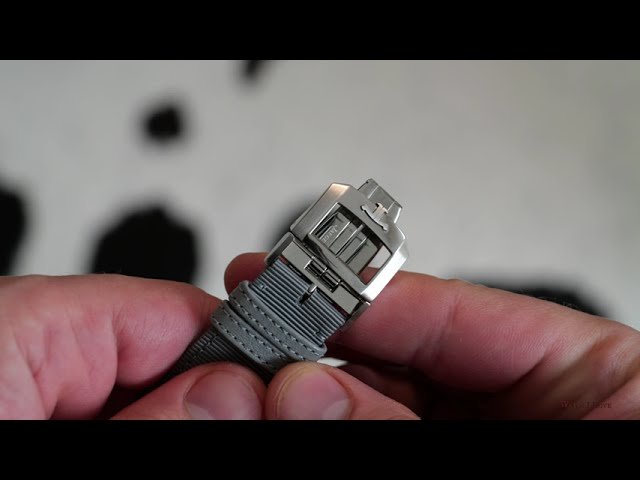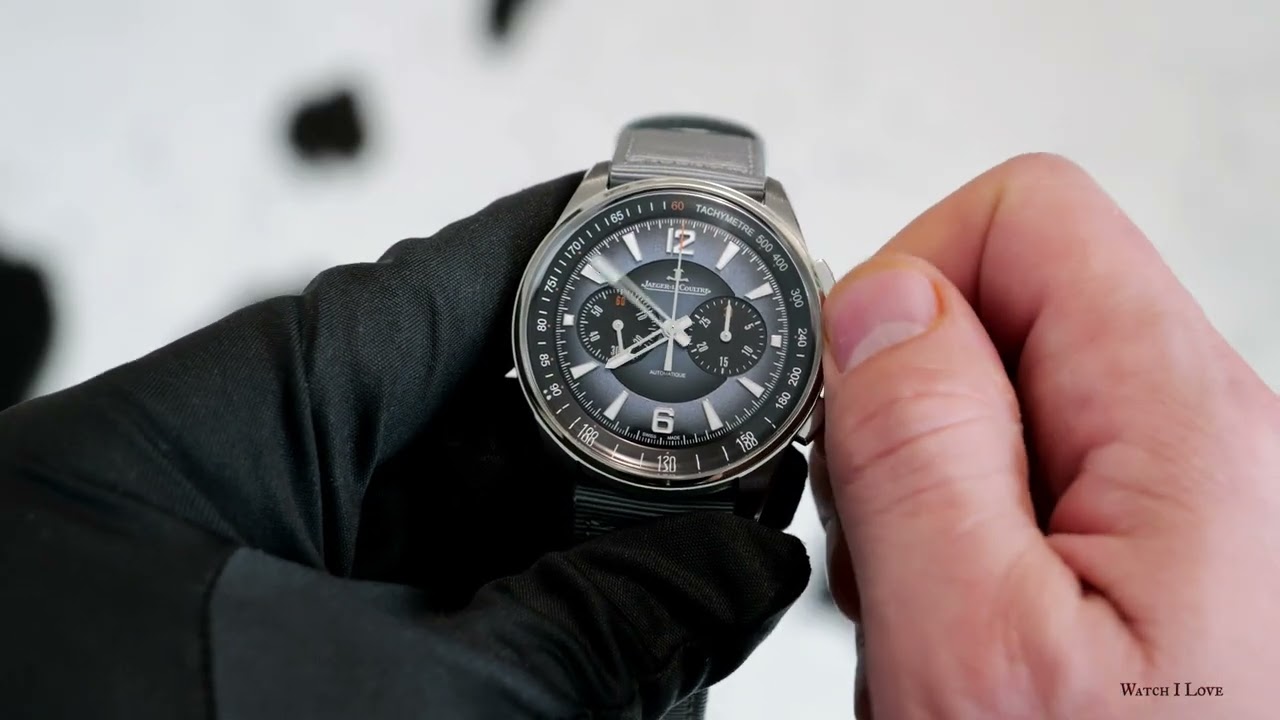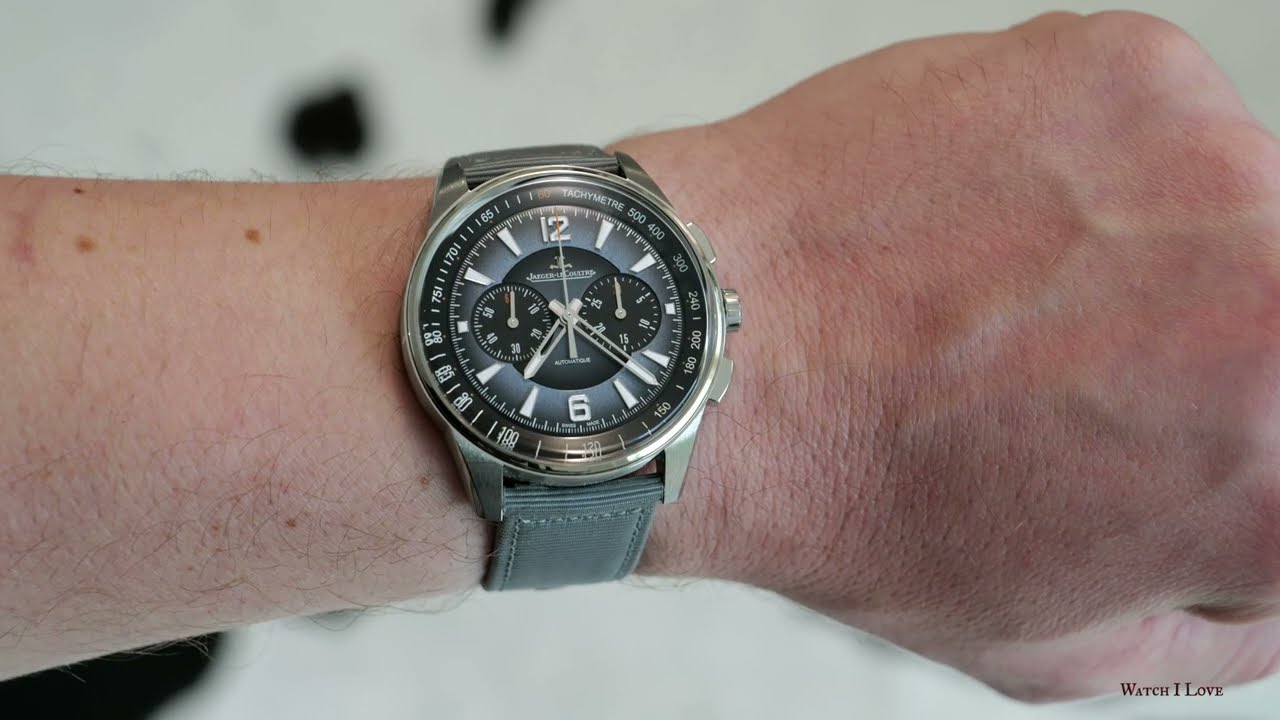Sports watches hold a peculiar position in contemporary horology. They must balance robust functionality with refined aesthetics, creating timepieces that feel equally at home beneath a wetsuit or a shirt cuff. The finest examples achieve this duality not through compromise but through careful attention to every detail, every surface, every interaction of light and material. The Jaeger-LeCoultre Polaris Chronograph Ocean Grey Reference Q9028651 represents this philosophy made tangible, a watch where technical complexity serves visual elegance and vice versa. We had the watch for a week and we had some fun during an automobile show.

The Polaris Legacy: From Deep Sea Exploration to Contemporary Adventure
The Polaris story begins in the golden age of dive watch development, that remarkable period in the late 1950s and early 1960s when manufacturers raced to conquer the ocean depths. Jaeger-LeCoultre entered this arena in 1959 with the Deep Sea Alarm, the first diving watch equipped with a functioning underwater alarm mechanism. This was no mere parlour trick since the alarm had to be loud enough to penetrate water, wetsuit, and the ambient noise of the underwater environment.

By 1963, development work had begun on what would become the Memovox Polaris, released to the public in 1965. The watch measured 42mm in diameter, exceptionally large for its era, and achieved 200 metres of water resistance through an innovative triple-caseback construction. The outermost caseback featured 16 perforations to allow the alarm sound to escape; beneath this sat a water-resistant compression caseback using EPSA’s revolutionary sealing system; and innermost, a bronze resonator that amplified the alarm mechanism.

Production numbers remained limited: only 1,714 examples were manufactured between 1965 and 1970. In 1968, Jaeger-LeCoultre refined the dial design, introducing trapezoid-shaped hour markers and luminescent material throughout, creating the most recognizable iteration of the Polaris aesthetic. This 1968 design became the blueprint for the contemporary Polaris collection launched in 2018, which reinterprets that vintage diving spirit through the lens of modern sporty-chic watchmaking. Those familiar with our Youtube Channel may recognise the 2018 model that I photographed at Jaeger-LeCoultre booth.

Thirty-Five Layers of Patient Craftsmanship
The Ocean Grey dial represents one of the most labour-intensive decorative processes in contemporary watchmaking. Understanding its construction requires appreciating both its physical structure and the meticulous coating process that brings it to life.

Structurally, the dial consists of three distinct components. At the centre sits a disc treated with sunray brushing, creating radial striations that catch and scatter light. Surrounding this, a middle ring receives the applied hour markers, its surface finished to a smooth gloss that contrasts with the textured centre. The outermost ring carries the tachymeter scale, printed in crisp detail.

The lacquering process begins with a clear varnish coat applied manually to the bare metal surface. This foundation ensures proper adhesion for the subsequent layers. Four coats of coloured lacquer follow, each applied by hand and allowed to cure before the next application. The craftsman then introduces a layer of black lacquer, carefully controlling its application to create the gradient effect that gives the dial its remarkable depth. Here lies the critical challenge: achieving perfect colour matching between the central disc and the hours ring. Both surfaces must transition from light to dark at identical rates despite their different finishes – one brushed, one smooth.

The gradient cannot appear too abrupt or too subtle. Temperature, humidity, application technique, and curing time all affect the final result. A single inconsistency renders the dial unusable. Following this delicate black layer, the artisan applies 30 coats of translucent lacquer. Each transparent layer adds depth, creating an almost three-dimensional quality to the colour beneath. The accumulated thickness of these 35 layers produces a richness that single-coat lacquering cannot achieve. Light penetrates several layers before reflecting back, creating subtle variations as the viewing angle changes.

The sub-dials at 3 and 9 o’clock receive circular graining, a concentric pattern of fine lines that adds textural contrast to the composition. The 30-minute chronograph counter occupies the 3 o’clock position, balanced by the running seconds display at 9 o’clock. This layout keeps the dial balanced and legible, avoiding the visual clutter that can plague chronograph designs.

Orange accents punctuate the grey palette, drawing the eye to functional elements. The central chronograph seconds hand wears this vibrant colour, as do the tips of the chronograph sub-dial hands and selected details on the hour markers. These touches inject dynamism into the composition while serving a practical purpose. They make the active timing functions immediately identifiable.

The applied hour markers take the form of bold trapezoids, their shape directly referencing the 1968 Polaris design. Their substantial size balances the visual weight of the chronograph sub-dials while providing clear reference points for time reading. Skeletonized hands are another Polaris signature, they reduce mass without sacrificing legibility, allowing greater visibility of the sub-dial indications beneath them. Luminescent material coats the hour markers, the numerals at 6 and 12 o’clock, and the hand tips, ensuring readability in darkness.

The tachymeter scale encircling the dial serves the traditional chronograph function of converting elapsed time into speed or frequency. The scale typically ranges from 60 to 500, representing units per hour. To measure speed, one starts the chronograph as an object passes a starting point, then stops it after the object travels one predetermined unit of distance. The chronograph seconds hand indicates the speed on the tachymeter scale: if 30 seconds elapsed, the hand points to 120, indicating 120 units per hour.

Calibre 761: Integrated Chronograph Architecture
The automatic Calibre 761 represents Jaeger-LeCoultre’s philosophy of integrated complication design. Rather than starting with a time-only movement and adding a chronograph module atop it, the manufacture designed this calibre from its foundation as a unified chronograph mechanism. This approach yields superior performance characteristics and a more refined mechanical architecture.

At the heart of the chronograph function sits a column wheel with vertical clutch. Column wheel mechanisms represent the traditional high-end approach to chronograph construction. The column wheel itself resembles a miniature castle turret, with vertical clutch arranged around a central axis. As the user activates the chronograph pushers, levers interact with these columns, engaging or disengaging the timing functions through precise vertical movements.

The vertical clutch system handles the connection between the constantly running gear train and the chronograph mechanism. When the chronograph starts, the clutch engages vertically, eliminating the lateral friction that causes the seconds hand to jump or stutter in cam-actuated systems. This produces seamless engagement, with the chronograph hand beginning its sweep without hesitation or positional shift. Operation feels refined at the pushers: sufficient resistance to prevent accidental activation, but smooth enough for rapid timing sequences.

Twin barrels power the movement, storing energy in two mainsprings rather than one. This configuration provides 65 hours of power reserve while delivering more consistent torque throughout the running period. As a mainspring unwinds, its output torque typically decreases; twin barrels help mitigate this effect, contributing to better chronometric performance across the full power reserve.

The movement operates at 28,800 vibrations per hour (4 Hz), the modern standard for mechanical chronographs. This frequency offers excellent precision while maintaining reasonable power consumption. With 35 jewels reducing friction at critical pivots and 248 total components working in concert, the calibre exemplifies mechanical complexity refined through decades of manufacture experience.

Visible through the sapphire exhibition caseback, the movement finishing demonstrates Jaeger-LeCoultre‘s decorative standards. Côtes de Genève, the iconic Swiss striped decoration adorns the baseplate and bridges. This finish consists of parallel lines created by systematically scratching the polished metal surface with a specialized tool. The resulting pattern catches light at different angles, creating a play of reflection and shadow across the movement surface.

The technique serves both aesthetic and practical purposes. The vertical striations add visual interest and depth to what would otherwise be flat metal surfaces. They also mask minor imperfections from machining processes, concealing tiny tool marks that might otherwise be visible on plain polished surfaces. At the haute horlogerie level, Côtes de Genève application requires skilled handwork to maintain perfectly parallel lines with consistent depth.

Blued screws provide colour contrast against the rhodium-plated movement. The bluing process involves carefully heating steel screws until they reach a precise temperature that produces the characteristic deep blue oxide coating. Too little heat yields pale blue; too much turns the screw purple or grey. The process requires both technical knowledge and artisanal judgment.

The openworked rotor bearing the ‘JL’ motif demonstrates functional decoration. Rather than using a solid gold rotor, Jaeger-LeCoultre skeletonized the automatic winding component, revealing its mechanical purpose while reducing mass. The cutaway JL logo serves as both brand signature and engineering feature, lightening the rotor without compromising its winding efficiency.

This movement finishing represents the standard Jaeger-LeCoultre applies across its manufacture calibres, the result of bringing 180 different watchmaking skills together under one roof in Le Sentier, in the heart of the Vallée de Joux. Founded in 1833 by Antoine LeCoultre, the manufacture became the first in the Vallée de Joux to unite all watchmaking crafts in a single facility rather than distributing work among cottage industry specialists.

This integration enabled the exchange of knowledge and techniques that continues to define the manufacture’s approach to calibre development. A big part if its history, the marque supplied ebauche and finalised movements to other big brands. While many consider the horological trinity as being Patek Philippe, Audemars Piguet, and Vacheron Constantin, none of them will be here today without Jaeger-LeCoultre. Even some of their modern iteratións are based on JLC movements. Let’s not forget that the maison has over 1400 calibres.

Functional Geometry
The 42mm stainless steel case balances visual presence with wearability. At 13.39mm thick, the watch achieves substantial wrist presence without crossing into unwieldy territory. These proportions echo the original 1968 Polaris, which at 42mm was considered remarkably large for its era. The case architecture expresses the contemporary Polaris design language: taut lines, sharply curving lugs, and a thin bezel that maximizes dial visibility. The lugs curve downward aggressively, wrapping the case around the wrist rather than extending outward from it. This geometry improves comfort and prevents the watch from appearing oversized despite its 42mm diameter.

A glass-box crystal sits atop the case, its domed profile creating vintage character while serving structural purposes. Domed crystals offer superior pressure resistance compared to flat alternatives, as the curved surface distributes external force more evenly across its area. For diving watches and sports timepieces, this geometry provides practical advantages in high-pressure environments. The double-domed construction, curved on both outer and inner surfaces, eliminates the optical distortion that single-domed crystals can introduce, maintaining clear dial visibility from all viewing angles.

The mix of brushed and polished surfaces across the case creates visual interest through contrasting light interaction. Brushed surfaces scatter light in directional patterns, appearing matte and subdued. Polished surfaces reflect light directly, creating bright highlights and dark shadows depending on viewing angle. The interplay between these finishes adds depth to what might otherwise read as a monolithic steel form.

Crown and pushers receive generous sizing, a design choice inherited from the 1960s original. The large crown facilitated operation while wearing diving gloves, transforming a potential liability into a functional advantage. The robust chronograph pushers continue this theme, offering secure grip and positive action feedback. The top pusher at 2 o’clock starts and stops the chronograph; the lower pusher at 4 o’clock resets the mechanism to zero.

Water resistance reaches 10 bar (100 metres), appropriate for recreational swimming and snorkelling though short of serious diving specifications. This rating acknowledges the watch’s intended use as an everyday sports timepiece rather than a specialized tool watch.
The watch ships with two interchangeable straps: textured black rubber and blue-grey canvas. The rubber strap suits active wear and aquatic environments, resisting water and perspiration while maintaining suppleness. The canvas option provides a more casual aesthetic, appropriate for daily wear in non-sporting contexts. The quick-change system enables strap swaps without tools, encouraging versatility in how the watch presents itself.
Complexity Serving Elegance
The Polaris Chronograph Ocean Grey succeeds because it refuses to compromise either its sporting capability or its refined execution. The 35-layer dial process, the integrated column-wheel chronograph, the carefully balanced case proportions, these elements work together rather than competing for attention. Jaeger-LeCoultre conceived the Polaris collection for everyday adventures, for timepieces that transition seamlessly between contexts without feeling out of place. The Ocean Grey dial colour reinforces this versatility, neither too casual nor too formal, equally comfortable in a board room or beside the ocean that inspired its name.

This watch demonstrates what happens when a manufacture with over 190 years of accumulated expertise applies itself to the sports chronograph category. The result transcends simple functionality, creating a timepiece where technical excellence and aesthetic refinement exist in genuine balance. The Polaris Chronograph Ocean Grey stands as evidence that sports watches need not sacrifice elegance for capability, with sufficient attention to detail, both qualities can coexist within 42mm of stainless steel.
We both enjoyed immensely. It even had more wrist time with Diana, I had to be happy with some movements in between. I was impressed by this Polaris iteration since its launch and I am happy I got the chance to have an intimate encounter. The dial is fantastic and the choice of straps very good, making it a lovely companion. At 16’000 € is not the cheapest chrono… But the offering is fantastic. I like the motorsport oriented look and the well designed inspiration from the vintage models. It is well anchored in present offering just hints of the past. And in case you are asking, yes, I would choose this reference instead of other chronos out there…

Jaeger-LeCoultre Polaris Chronograph Ocean Grey Technical Specifications
Reference Q9028651 – CHF 13’700 / EUR 16’000 / £ 13700 / US$ 16,100 / HK$ 119,000 / ¥ 2,398,000 / 21200 S$ / ¥ 123,000 / AED 59,000 / SAR 63,000 / AU$ 25,300
Functions
- Hours, minutes, small seconds; chronograph with 30-minute counter, central seconds
Movement
- Jaeger-LeCoultre Calibre 761
- Automatic winding
- Thickness: 5.76mm
- Frequency: 4 Hz / 28800 Vibrations per hour
- Power reserve: 65 hours
- Components: 248
- Jewels: 35
- Barrel: 2
Case
- Stainless steel
- Diameter: 42 MM
- Thickness: 13.39mm
- Water resistance: 10 bar
Dial
- Ocean grey lacquer: gray blue, sunburst, grained and opaline
- Luminescent numerals and hour-markers
- Hands: Bâton squeletté
Strap
- Black rubber
- Additional blue grey canvas strap
- Lug width: 21mm
- Interchangeable double folding stainless steel buckle
- Buckle width: 20mm































































